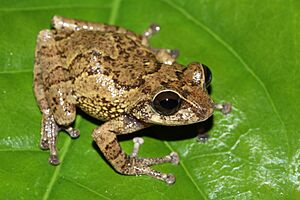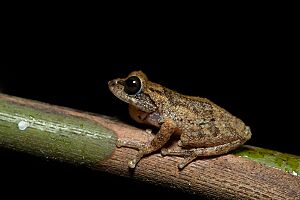Munnar bush frog facts for kids
Quick facts for kids Munnar bush frog |
|
|---|---|
 |
|
| Conservation status | |
| Scientific classification | |
| Synonyms | |
|
Philautus munnarensis Biju and Bossuyt, 2009 |
The Munnar bush frog (scientific name: Raorchestes munnarensis) is a special kind of frog. It belongs to the Rhacophoridae family, which are often called "tree frogs." This frog is found only in one small area of India. It lives near Munnar, in a place called Kerala, within the southern Western Ghats mountains.
Where It Lives (Habitat)
This frog lives in a very small area, less than 20 square kilometers. That's about the size of a small town! It prefers areas with secondary vegetation, which means forests that have grown back after being disturbed. Scientists found these frogs near tea plantations, but not actually inside them.
The Munnar bush frog lays its eggs on land, and the young frogs hatch directly from the eggs. They do not go through a tadpole stage in water. This frog's natural home has been changed a lot by humans.
Some of these frogs live in protected areas. These include Eravikulam National Park and Anamalai Tiger Reserve. Scientists believe that about half of all Munnar bush frogs live in these two parks.
What Threatens It (Threats)
The Munnar bush frog is in danger because its home is being destroyed by people. This is called habitat loss. Forests are being cleared to make room for tea and eucalyptus plantations. This is a big problem because there are no other suitable places for these frogs to live nearby.
Scientists are also worried about climate change affecting the frogs. Another threat is a fungal disease called chytridiomycosis. This disease is caused by a fungus named Batrachochytrium dendrobatidis. This fungus has harmed other types of frogs in the same group as the Munnar bush frog. Because of this, scientists think the Munnar bush frog might also be at risk from this disease.
How We Can Help (Conservation)
It is very important to protect the places where the Munnar bush frog lives. Right now, the main area where this frog is found is not fully protected. Saving its remaining home is a top priority to help this unique frog survive.



